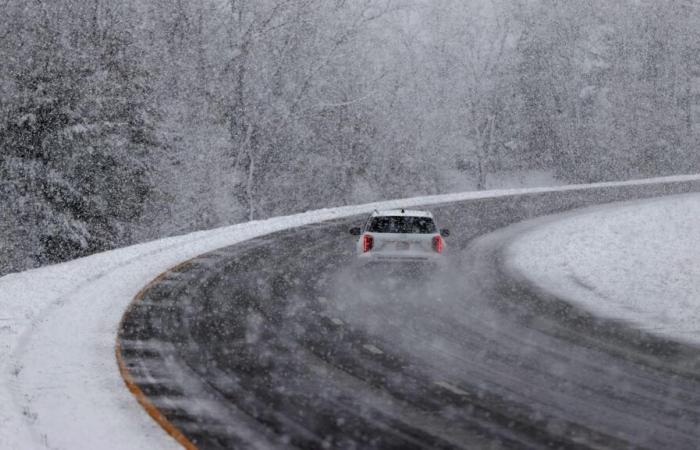Topline
Winter storm warnings going into the week of Thanksgiving stretch from California to the East Coast and the potential for snow—particularly in the Northeast—could impact plans as travel is expected to rebound to pre-pandemic levels for the first time.
A car maneuvers through a snowy I-95 South near Boston.
Boston Globe via Getty Images
Key Facts
Winter storms are expected for California and Nevada’s Sierra Nevada mountains through Wednesday, the National Weather Service warns, with up to 3 feet of snow falling at higher elevations.
Parts of Maine, Vermont, New Hampshire and the Eastern Adirondacks of New York are under a winter weather advisory for Tuesday morning, with freezing rain and icy road conditions expected to impact travel.
A cold front is expected to sweep the Midwest and South starting Wednesday night and spread East on Thanksgiving Day, bringing precipitation and frigid temperatures.
What path the storm will take is still unclear—making it hard to predict where snow may fall on Thanksgiving Day and Friday—but low pressure tracking near New England is bringing the potential for widespread rain and snow to the region from Thursday into Friday morning, according to the National Weather Service.
Snowfall on Thursday and into Friday is possible in northern New York and Vermont and rain and high-elevation snow could be seen on Thanksgiving in northwestern Connecticut, western Massachusetts and eastern New York.
Those traveling by car in areas from Boston to New York City should be prepared for a wet drive, be it snow or heavy rain.
A surge of cold the weekend after Thanksgiving will send freezing weather to the Great Lakes Midwest and Northeast with high temperatures in the 20s expected in Chicago, Pittsburgh and Columbus, Ohio.
Get Forbes Breaking News Text Alerts: We’re launching text message alerts so you’ll always know the biggest stories shaping the day’s headlines. Text “Alerts” to (201) 335-0739 or sign up here: joinsubtext.com/forbes.
What To Watch For
How weather impacts travel. Almost 80 million people are expected to travel more than 50 miles between Tuesday and next Monday for the holiday. Car travel is expected to overtake pre-pandemic levels—70.6 million people drove to their Thanksgiving destinations in 2019, AAA reports, and 71.7 million are expected to do so this year. Almost 6 million people are expected to fly domestically, up 11% from 2019 and international bookings are up 23% compared to last Thanksgiving. Tuesday and Wednesday afternoons are the worst time to travel by car, AAA reported, with road congestion also expected almost all day Sunday, particularly after 1 p.m.
Tangent
Workers at Charlotte Douglas International Airport, a hub for American Airlines and one of the nation’s busiest airports, went on strike Monday to demand higher wages. It’s unclear if the strike will extend through the holiday travel period, but the airport told the Charlotte Observer the strike of workers who handle on-board trash removal, cabin cleanup and wheelchair escorts isn’t impacting airport operations.
Surprising Fact
It’s been five years since Thanksgiving brought seriously destructive winter weather to portions of the United States. In 2019, a bomb cyclone brought almost hurricane-force winds to the West Coast and rains that flooded San Diego. Hail fell in Los Angeles the day before Thanksgiving, and three members of an Arizona family died after their truck was swept away in a flooded creek. The year before, in 2018, New York City saw the coldest Thanksgiving since 1901 when temperatures in Central Park hit 19 degrees and East Coast other cities, including Washington D.C., also had near record-breakingly cold temperatures.
Further Reading
ForbesThanksgiving Air Travel Set For Record High As Travel Finally Returns To Pre-Pandemic LevelsBy Mary Whitfill Roeloffs
ForbesU.S. May See A Healthy Thanksgiving—But Covid, RSV Could Spike Before Christmas, CDC WarnsBy Mary Whitfill RoeloffsForbesThanksgiving Shopping: A Store Brand Meal Is Nearly $20 Less Than Name Brand, Report SaysBy Molly Bohannon






